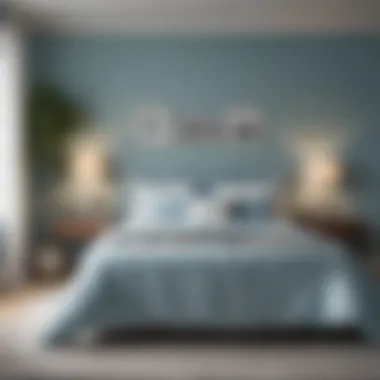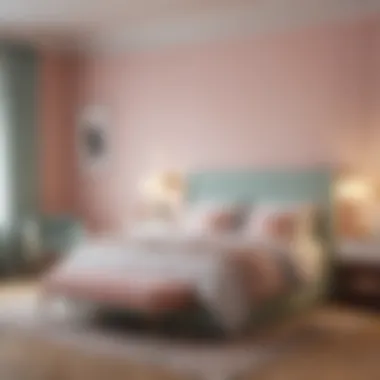Exploring Popular Paint Colors for a Bedroom: A Comprehensive Guide


Intro
Choosing the right paint color for a bedroom is more than just a cosmetic decision. It influences the overall atmosphere and the psychological responses of those who inhabit the space. Popular paint colors possess the ability to create an ambiance that encourages relaxation or stimulation, making it crucial to select the right hues. This guide will navigate through various color palettes, discussing their impact on mood, compatibility with light, and practical application tips.
As we progress through this article, we will explore a spectrum of colors, including their trending popularity and timeless choices. Furthermore, an emphasis will be placed on how decor elements, such as lighting and furniture selection, work hand-in-hand with color to create a cohesive design. This guide is tailored for discerning individuals who appreciate aesthetics in every detail, empowering readers to make informed choices for their personal sanctuaries.
Popular Color Palettes for Bedrooms
Selecting a paint color involves understanding current trends while also considering personal preferences. Common choices include soft neutrals, calming blues, and invigorating greens. Each of these colors brings a unique psychological benefit that can enhance your bedroom experience.
Soft Neutrals
Soft neutral shades like beige, cream, or light gray offer a backdrop that promotes relaxation. These colors are versatile and can complement various decor styles, from traditional to modern. They create a serene environment, making them a popular choice for many homeowners.
Calming Blues
Blue shades, particularly light or pastel variants, are renowned for their calming effects. Blue evokes feelings of tranquility, making it ideal for bedrooms. It pairs well with white or natural wood furnishings, enhancing a fresh, airy ambiance.
Invigorating Greens
Green hues bring a sense of renewal and balance. Shades like mint or sage can create a refreshing atmosphere. These colors work well with indoor plants, providing a natural touch that enhances well-being.
Studies suggest that colors significantly impact mood and can influence behavior in various ways.
The Interplay of Light and Color
Understanding the interaction between light and color is vital. Natural and artificial lighting can alter the appearance of colors on your walls. For example, a room with ample natural light can make softer shades appear brighter, while the same color may appear duller in low light conditions.
Practical Tips for Application
When considering paint for your bedroom, it is crucial to test samples on your walls first. Observe how the colors change throughout the day as lighting shifts. It is also advisable to think about finishes—matte, satin, or gloss—since they can further influence how colors are perceived.
Current Trends in Bedroom Colors
Staying abreast of current trends can inform your choices. Earthy tones and rich jewel colors have made a significant impact. Relying on these choices can modernize spaces and reflect a sense of refined luxury.
Timeless Choices
While trends come and go, certain colors remain perennial favorites. Shades like white, gray, and blue have stood the test of time, primarily due to their versatility and broad appeal.
In the pursuit of creating the ideal bedroom environment, understanding popular paint colors and their implications offers a foundation for personal expression and tranquility. In the following sections, we will transition into how decor elements align with these color choices, enhancing overall aesthetics and functionality.
Understanding the Importance of Color in Bedroom Design
Color plays a pivotal role in interior design, especially in spaces meant for relaxation and rejuvenation. The bedroom, as a personal retreat, should reflect an atmosphere that aligns with its user’s preferences and needs. Choosing the right paint colors can significantly influence not only the aesthetic appeal but also the overall feel of the room. Given that bedrooms are spaces of rest, the color selections can foster tranquility or energy depending on the desired mood.
Moreover, the choice of color extends beyond personal taste; it is directly tied to psychological impacts, which can affect mental states. Colors can uplift moods, calm anxiety, or indeed inspire creativity. Thus, understanding the fundamental importance of color in this environment is crucial for making informed decisions.
The Psychological Effects of Color
Colors evoke emotions and influence thoughts in various, often profound ways. Warm colors like reds and yellows can instigate feelings of warmth and comfort. However, they may also create a sense of overwhelming urgency if used excessively. Cool colors such as blue and green promote calmness and serenity, making them ideal for a restful bedroom environment.
Research has shown that color can trigger specific mental responses, affecting heart rates and even blood pressure. For example, light blue or soft green hues are associated with tranquility.
It’s advisable to consider these psychological impacts carefully when selecting paint colors. It is not just about what looks good but also about how it makes the inhabitant feel.
“Color is a power which directly influences the soul.” – Wassily Kandinsky
Functional Aspects of Color Choice
The functional aspects of color choice extend into the realms of room size, layout, and light considerations. Lighter colors can create an illusion of space, making a smaller room appear larger. Darker shades may emphasize coziness but can also make a small space feel cramped if not balanced correctly.


Lighting interacts closely with color. Natural light can bring out the subtle variations in hues, while artificial lighting can dull them. Therefore, it is vital to test how different colors appear under varying light conditions before finalize choices.
Additionally, the purpose of the bedroom can dictate color choice. For a space aimed at relaxation, opting for soothing colors would be ideal. In contrast, a home office incorporated into a bedroom may benefit from more stimulating colors to enhance focus and productivity.
In summary, the importance of color in bedroom design is multifaceted. It affects psychological well-being, shifts spatial perceptions, and responds dynamically to light. Thus, an thoughtful approach to color selection is fundamental for creating an inviting and harmonious bedroom environment.
Popular Color Choices for Bedrooms
The color palette chosen for a bedroom significantly shapes the overall feel and ambiance of the space. Understanding the popular color choices allows individuals to tailor their personal retreats to their preferences and needs. These selections can enhance relaxation, incite creativity, or even promote restful sleep. The key is to choose colors that resonate personally while considering how they will interact with the room’s natural light and furnishings.
Neutral Tones
Neutral tones form the foundation of many bedroom color schemes. They offer flexibility, creating a backdrop that can adapt over time or with changing decor. These colors typically create a calm and serene atmosphere, making them a favored choice for those seeking tranquility.
Soft Whites
Soft whites are highly regarded for their ability to evoke a sense of spaciousness and cleanliness. This color creates a glare-free brightness that can make a room feel larger. The subtle undertones in soft whites can range from warm to cool, allowing for a tailored match with various furnishings.
One significant aspect of using soft whites is their compatibility with other colors. They serve as an excellent canvas for adding bold accents or colorful decor. However, the downside may include the challenge of maintaining its pristine appearance, as stains can be more visible.
Beige Variations
Beige variations encompass a broad spectrum from warm tones to cooler shades. This category can provide a cozy and inviting feel to a bedroom. The versatility of beige means it can complement both modern and traditional styles effectively.
A distinctive feature of beige variations is their capacity to harmonize with an array of accent colors. This adaptability makes beige a beneficial choice while also providing a warm backdrop. On the flip side, too much beige can lead to a washed-out effect when not paired with brighter accents or textures.
Gray Shades
Gray shades have surged in popularity as a sophisticated alternative to traditional neutral colors. They can range from light to dark hues, providing options to match diverse styles and preferences. Gray is often viewed as modern and elegant, appealing to a high-end audience.
The unique quality of gray lies in its ability to reflect light in varied ways throughout the day, offering depth and dimension to the space. However, choosing the wrong undertone—cool or warm—can lead to an undesirable atmosphere, making it crucial to select the appropriate shade thoughtfully.
Bold Colors
Bold colors can inject drama and personality into a bedroom. They often ignite strong emotions and can become a focus point of design. Although they require careful consideration to balance their intensity, well-executed bold colors can elevate a bedroom from mundane to striking.
Navy Blue
Navy blue is a deep, rich color that instills a sense of calmness akin to a night sky. Its substantial character allows it to dominate a room without overwhelming it. Navy blue is also flexible; it pairs well with various metal finishes and wood tones.
This color's daring aspect is its ability to create a cozy feel in larger rooms, as it absorbs light and induces warmth. Conversely, if used excessively, it might darken a small space, so careful use is crucial.
Emerald Green
Emerald green conjures visions of nature and tranquility, making it a compelling option for a bedroom. This vibrant color exudes richness and depth, often seen as a statement choice that showcases individuality.
Emerald green stands out well against neutral palettes, adding a touch of elegance without being overbearing. Its disadvantage lies in its potential to overwhelm if not balanced properly with lighter or neutral elements.
Burgundy
Burgundy embodies warmth and richness, often linked to luxury and sophistication. This color can create a dramatic backdrop or add subtle depth to the decor. It provides an inherent coziness to the bedroom, making the space feel inviting.
One of the key characteristics of burgundy is its association with opulence. However, its intensity may require careful pairing with lighter colors or contrasting shades to prevent the room from feeling too heavy.
Pastel Colors
Pastel colors range from soft pinks to gentle greens, creating soothing and serene environments. These hues are particularly popular for fostering a peaceful atmosphere conducive to relaxation and sleep.
Soft Pink
Soft pink has become synonymous with a delicate and nurturing ambiance. This light shade can instill a sense of comfort and warmth, making it ideal for a cozy bedroom.
The unique feature of soft pink is its versatility; it can adapt well with both traditional and modern decor styles. However, overuse might lead to an overly feminine space, which may not appeal to all.


Mint Green
Mint green is refreshing and inviting, reminiscent of spring. This light hue encourages a sense of renewal and creativity. Its vibrant nature can enliven a space while still promoting calmness.
Mint green's advantage is its compatibility with white and wooden tones, making it easy to incorporate into existing decor. A possible disadvantage is that the brightness of mint may fade when not adequately lit, making lighting considerations critical.
Light Lavender
Light lavender offers a soft, dreamy quality, making it perfect for a relaxing environment. This pastel tone is often associated with calmness and can promote restful sleep.
The beauty of light lavender is its versatility; it pairs beautifully with both warm and cool colors. However, it can sometimes be viewed as too whimsical if not balanced properly with more grounded shades.
Earthy Tones
Earthy tones connect to nature, creating grounded and organic atmospheres in bedrooms. This category encompasses a range of warm and muted colors, leading to a tranquil, retreat-like feel.
Terracotta
Terracotta is a warm, muted orange that evokes the essence of sun-soaked earth. It adds a rustic charm and can be striking against greenery or natural wood. This color creates a cozy feeling while contributing to an organic aesthetic.
One strength of terracotta is its ability to warm up a room without being overly aggressive. However, it may require thoughtful accents to avoid feeling monotonous.
Olive Green
Olive green offers an earthy, sophisticated tone that resonates with nature. Its muted quality allows it to blend seamlessly into various design styles while providing depth to the space.
Olive green's significant characteristic is its warm undertone, which can enrich both light and dark furnishings. The challenge with olive green is its potential to darken a small room if not paired appropriately with lighter decor.
Umber
Umber is a rich brown hue that can often evoke a sense of stability and warmth. This color complements a variety of palettes, making it a robust choice for grounding a room's design.
The unique feature of umber is its ability to create a cozy feeling even in larger spaces. Yet, excessive umber can lead to a space that feels overwhelmingly dark and closed in, so careful balance with lighter shades is advisable.
Combining Colors for A Harmonious Effect
Combining colors effectively is vital in creating a bedroom that feels unified and visually appealing. Well-chosen color combinations enhance the overall atmosphere and can evoke specific emotions or reactions. Understanding how to mix colors helps to mitigate clashes and fosters a space of comfort and tranquility. This section explores methods to blend colors seamlessly while considering personal style and functional design.
Accent Walls
An accent wall can serve as a striking focal point in a bedroom. This element adds depth and character without overwhelming the other colors in the room. Choosing a bold hue for an accent wall, such as deep navy or rich emerald, can create contrast against more subdued shades on the remaining walls. When selecting a color, consider the light in the room, as certain shades may look different under various lighting conditions.
For instance, a warmer light may enhance the richness of a burgundy wall, while cooler light can make pastel colors appear more vibrant. It is advisable to visualize how the accent color interacts with the existing palette before committing.
Ultimately, an accent wall gives a chance to express personality while maintaining balance.
Color Blocking Techniques
Color blocking refers to the strategic use of contrasting colors in distinct sections of a bedroom. This technique brings a modern and energetic vibe, particularly appealing in contemporary designs. To effectively employ color blocking, consider using complementary colors across different furniture pieces, textiles, and wall sections. For example, pairing a soft light gray with a bold mustard yellow can create a dynamic interplay that captures attention.
When using color blocking, ensure that the selected colors harmonize well with each other and the overall theme of the bedroom. Having three to four complementary colors can result in a rich palette that feels cohesive rather than chaotic. Pay attention to how the colors integrate with the room's architecture, furnishings, and personal decorations for a refined outcome.
Using Textures with Colors
Incorporating textures alongside colors adds dimension and visual interest to a bedroom. Textiles, finishes, and patterns help to amplify the effect of your color choices. For instance, a soft velvet curtain in a muted hue can complement a wood-paneled wall, creating a luxurious and warm atmosphere.
Different textures can soften or intensify color perceptions. Glossy surfaces may enhance brightness, while matte finishes provide a muted effect. Layering different materials, like a wool throw over a cotton bedspread, showcases the chosen colors in varying lights and contexts.
Additionally, don't shy away from mixing patterns. Patterns can bring colors to life, whether through bedding, art, or even wallpaper. Just remember to maintain a balance to avoid overwhelming the space. By thoughtfully combining textures with colors, the bedroom can express sophistication and comfort simultaneously.
Effective color combinations enrich the bedroom environment, fostering both aesthetic appeal and personal expression.


Trends in Bedroom Paint Colors
The choice of paint colors for bedrooms goes beyond mere aesthetics; it reflects current trends that combine practicality and style. As people seek personal retreats, understanding the trends in bedroom paint colors becomes essential. These trends provide insight into what resonates with contemporary design sensibilities, enabling homeowners to create spaces that resonate with them on a deeper level. Moreover, being aware of these trends helps in making informed decisions that align with evolving tastes in interior design.
Current Trends to Consider
Currently, several paint color trends are gaining traction in bedroom design:
- Warm Neutrals: More homeowners are leaning towards colors like soft taupe or creamy beige. These hues form a perfect backdrop and create inviting atmospheres.
- Bold Accents: Deep shades like navy blue or emerald green are finding their way into bedrooms, often through accent walls. This adds drama and sophistication.
- Natural Tones: Shades that mimic the earth, such as terracotta and olive green, are also popular. These colors provide a calming effect, reminiscent of nature.
- Pastels: Soft colors such as mint green or light lavender are favored for their tranquil feel. They reflect softness and provide a gentle aesthetic, ideal for relaxation.
"Color choice in bedroom design aligns with both individual taste and broader trends, creating spaces that are uniquely personal yet contemporarily relevant."
Timeless Choices
While trends come and go, some choices remain consistently appealing over time:
- Soft Whites: A classic white bedroom invokes cleanliness and simplicity, making spaces feel open and airy. It serves as a versatile base for other design elements.
- Gray Shades: Light to mid-tone grays have proven to be timeless. They work well with nearly any color scheme and provide a sophisticated modern appeal.
- Beige Variations: Varieties of beige are also enduring favorites. They offer warmth and complement various styles from traditional to contemporary.
- Deep Hues for Statement Pieces: Colors like burgundy can be used sparingly to create a focal point without overwhelming the space.
Being aware of both current trends and timeless choices allows one to strike a balance, facilitating design decisions that honor personal style while remaining in harmony with the evolving landscape of interior design.
Practical Tips for Choosing Bedroom Paint Colors
Choosing the right paint color for a bedroom is essential for creating a space that feels inviting and reflects personal taste. Practical tips in this section will guide stakeholders in high-end interior design, luxury travel curation, and other related fields through the decision-making process. The focus is on making choices that enhance not only aesthetics but also the functionality of the space.
Assessing Room Size and Light
The room's size and the quality of light it receives are critical components in color selection. This factor can dramatically influence how a color appears. For instance, smaller rooms benefit from lighter shades that create an illusion of space. Soft whites or light grays are typically effective here.
In contrast, larger rooms may embrace bold colors, allowing for more visual interest without making the space feel cramped. Consider the orientation of windows; a north-facing room often requires warmer tones to compensate for lack of sunlight, while south-facing rooms can support cooler colors.
- Factors to evaluate:
- Size of the room
- Direction of natural light
- Time of day and seasonal changes in lighting
Testing Paint Samples
Before committing to a color, testing is paramount. Paint can appear different on the wall than it does on sample cards. It can change with varying light throughout the day. To achieve an accurate view, purchase small paint samples and apply them on a large swatch on the wall.
Observe the colors in different lighting conditions—morning, afternoon, and evening. This method offers important insights into how the colors interact with existing furnishings and decor.
- Testing checklist:
- Choose multiple swatches
- Observe under various lighting conditions
- Assess compatibility with existing furnishings
Incorporating Personal Style
To create a bedroom that truly feels like a retreat, personal style must come into play. This involves reflecting one's individuality through color choices. Are the preferences contemporary, bohemian, or classic? Understanding this will aid in selecting a palette that resonates personally.
Consider integrating accessories or artwork that showcases individuality. These elements can harmonize with chosen paint colors, creating a cohesive yet distinct atmosphere.
- Style considerations:
- Color palettes that resonate personally
- Choose accents and décor that align
- Balance between bold and subtle choices
Conclusion: Thoughtful color selection for bedrooms hinges on understanding room dynamics and personal aesthetics. Practical tips assist in navigating the complexities of this process, enabling a harmonious and stylish finish.
Ending
The choice of paint color for a bedroom holds significant weight in creating a personal retreat. It impacts not only the aesthetic appeal but also the emotional and psychological environment of the space. The colors that envelop us have a tendency to influence our moods, comfort, and overall sense of well-being. This article has examined various popular paint colors, their meanings, and their suitability in a bedroom context.
Final Thoughts on Bedroom Colors
When selecting bedroom colors, it is crucial to consider personal preferences alongside the practical implications of light and room size. Each color comes with its own personality and evokes varied emotional responses. For instance, soft whites can create a serene atmosphere, while bold colors such as navy blue can add depth and drama.
Additionally, the current trends and timeless choices highlighted in this guide equip readers with the knowledge to make informed decisions. Incorporating color can lead to a more cohesive and inviting space. Testing paint samples, understanding light dynamics, and considering individual style all contribute to a harmonious bedroom.
"The right color can change the mood of a room, enhancing one's luxury experience in personal space."
Ultimately, the goal is to find a balance that reflects both style and comfort, making it essential to approach color selection thoughtfully. In this way, the bedroom can evolve into a true sanctuary, tailored to individual taste while harnessing the positive attributes of chosen colors.







